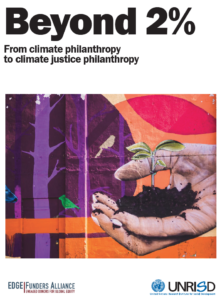Beyond 2%: From climate philanthropy to climate justice philanthropy
Philanthropic foundations have long exerted influence in the international climate arena. Over 30 years on from their early forays into climate debates, this report asks how effective they have been. How relevant are their theories of change and worldviews today? And what can philanthropic foundations do to position themselves at the vanguard of meaningful change in the climate arena?
In partnership with the United Nations Research Institute for Social Development (UNRISD), the EDGE Funders Alliance launched this report on climate philanthropy that takes a fresh look at the state of play in the sector, and sets out the case for grounding climate philanthropy in climate justice and just transition principles.
REPORT’S FOCUS
 The report lays out a series of possible “next steps” towards a qualitative shift from climate philanthropy to climate justice philanthropy. These include:
The report lays out a series of possible “next steps” towards a qualitative shift from climate philanthropy to climate justice philanthropy. These include:
- Identifying examples of initiatives at the foundation and movement levels that can inspire further action.
- Creating and cultivating spaces for movement/funder dialogue, strategizing and action.
- “Occupying climate philanthropy”: Organizing progressive funders to ensure that climate justice voices are heard, and approaches are represented, within the climate philanthropy space.
The report draws on discussions within the EDGE COP26 Working Group, which brings together funders and climate movement actors; one-on-one conversations; and written materials produced by funder networks, foundations and academics.
KEY FINDINGS
1. The need for a qualitative shift
 2%—that is the estimated share of philanthropic dollars allocated to climate-related issues. In the run-up to the all-important Paris Climate Conference in 2015, “2%” was a rallying cry to get more grant dollars flowing towards climate action. In an April 2015 opinion piece for the Chronicle of Philanthropy, Larry Kramer of the Hewlett Foundation and Carol Larson of the Packard Foundation expressed their dismay that “currently less than 2 percent of all philanthropic dollars are being spent in the fight against climate change.” [1] Just over six years later many philanthropies still refer to the 2% figure, seeking both to highlight the importance of philanthropy in addressing the climate problem, and to get more foundations to commit funds to climate action [2].
2%—that is the estimated share of philanthropic dollars allocated to climate-related issues. In the run-up to the all-important Paris Climate Conference in 2015, “2%” was a rallying cry to get more grant dollars flowing towards climate action. In an April 2015 opinion piece for the Chronicle of Philanthropy, Larry Kramer of the Hewlett Foundation and Carol Larson of the Packard Foundation expressed their dismay that “currently less than 2 percent of all philanthropic dollars are being spent in the fight against climate change.” [1] Just over six years later many philanthropies still refer to the 2% figure, seeking both to highlight the importance of philanthropy in addressing the climate problem, and to get more foundations to commit funds to climate action [2].
Yet numbers can be misleading. Whether the actual figure is just over or just under 2%, focusing on the amount of philanthropic funding distracts us from important questions: Where do funds originate, and to what and to whom are they allocated? What is the place, function and legitimacy of philanthropy in the climate debate? What qualifies as climate philanthropy (and what does not)? And what theories of change and world views drive philanthropic giving in the climate field?
[1] https://www.philanthropy.com/article/Foundations-Must-Move-Fast-to/229509 [2] https://www.climateworks.org/report/funding-trends-climate-change-mitigation-philanthropy/; https://www.alliancemagazine.org/magazine/issue/june-2021/
2. Moving beyond market-centric “win-win” solutions
 In answering these questions, this report argues that the approaches to climate philanthropy, and the strategies that currently underpin the 2% figure, are outdated and ineffective. Foundations’ support to market-centric and corporate-driven “win-win” solutions has not resulted in lower emissions, nor has it improved the fate of frontline workers and communities in the Global South and North.
In answering these questions, this report argues that the approaches to climate philanthropy, and the strategies that currently underpin the 2% figure, are outdated and ineffective. Foundations’ support to market-centric and corporate-driven “win-win” solutions has not resulted in lower emissions, nor has it improved the fate of frontline workers and communities in the Global South and North.
For climate philanthropy to make effective and meaningful contributions to a just low-carbon transition, climate justice needs to be placed at the heart of all foundation efforts in the climate space. A growing number of foundations now acknowledge the importance of climate justice and just transition, but they are still treated as subsidiary issues in support of what fundamentally remains a “business-as-usual” approach to climate action. A qualitative shift is urgently needed. Climate justice cannot be a mere “add-on”; it must be at the very centre of all philanthropic efforts to address the climate crisis. Foundations must collectively and strategically embark on a wholesale transformation.
3. Radically rethinking philanthropy’s role
 At the individual foundation level: Change the relations of power and influence within philanthropic foundations. Change the ways in which individual foundations engage with their grantees and society more broadly.
At the individual foundation level: Change the relations of power and influence within philanthropic foundations. Change the ways in which individual foundations engage with their grantees and society more broadly.
At the philanthropic sector level: Change the culture within the sector by making it more respectful and accountable to grantees and society as a whole. Develop new joint strategies and alignment through funder organizing that is centred on climate justice and just transition.
At the system level: Embrace climate justice and systems change approaches to philanthropy, acknowledge philanthropy’s role and responsibilities. Align grant making and other philanthropic activities with a radical climate justice agenda.
Don’t have time to read the full report?
Download the 2-pager to get a glimpse of the content
Want to stay engaged in the topic?
Sign up to be part of the Climate Justice Working Group at EDGE.
REPORT GLOSSARY
- Carbon capture and storage
- Cap and trade system
- Climate capitalism
- Climate Justice
- COP15
- Divest-Invest
- Frontline communities
- Grassroots movements
- Just transition
- Market-based climate solutions
- Mitigation
- Negative-emissions technologies (also known as Greenhouse Gas Removal technologies)
- Net Zero
- Systems change philanthropy
- Trust-based philanthropy
The process of capturing and storing carbon dioxide formed during power generation and industrial processes before its release into the atmosphere.
Refers to government regulatory programmes designed to limit (cap) the total level of emissions of carbon dioxide by allowing the market to determine a price on carbon. Businesses are imposed an upper limit on the amount of emissions they can produce but have the possibility of increasing their capacity by purchasing allowances from organizations that have not used their full allowances.
Jean Philippe Sapinski defines climate capitalism as “a regime of capital accumulation founded on climatically benign production technologies and increased energy efficiency. Developed within the bounds of neoliberal environmentalism, climate capitalism is founded on market mechanisms, mainly carbon trading and carbon taxes” (Sapinski, 2016:89-90).
A term, and more than that, a movement that acknowledges the systemic nature of the climate crisis, and its differentiated effects on vulnerable, marginalized and underprivileged groups.
Usually refers to the 2009 United Nations Climate Change Conference held in Copenhagen, Denmark. The conference included the 15th Conference of the Parties (COP15) to the United Nations Framework Convention on Climate Change (UNFCCC). An international framework for climate change mitigation beyond 2012 was to be agreed there. COP15 is generally considered as a failure given that Parties to the UNFCCC were unable to agree on a legally binding agreement or legally binding commitments for reducing emissions.
Usually refers to “a commitment to sell investments in fossil-fuel companies and invest instead in companies providing solutions to climate climage change” (DivestInvest 2018).
Refers to groups of people who experience the most immediate and worst impacts of climate change.
An organized effort that mobilizes people at the local level to effect change.
A unifying vision and set of principles, processes, and practices that empower communities and workers so that the transition towards a low-carbon, regenerative economy is fair and inclusive.
Policy interventions that use price signals and similar market incentives to shift consumer and producer behaviors towards more resource efficient and less carbon intensive onesways.
Climate change mitigation refers to efforts to reduce or stabilize the levels of heat-trapping greenhouse gases in the atmosphere.
Technologies that are intended to remove and sequester greenhouse gases from the atmosphere. Bioenergy with carbon capture and storage (BECCS) is widely regarded as the negative emissions technology that offers the most promise.
Refers to a target whereby the amount of greenhouse gases going into the atmosphere is balanced by removal out of the atmosphere.
An approach to philanthropy which recognizes that solving the world’s biggest problems will require addressing their root causes (rather than the symptoms) through collaborative efforts and changes to the policies, power dynamics, norms, mind sets and practices that underpin them.
According to the Trust-based philanthropy network, “trust-based philanthropy is about redistributing power—systemically, organizationally, and interpersonally—in service of a healthier and more equitable nonprofit sector. On a practical level, this includes multi-year unrestricted funding, streamlined applications and reporting, and a commitment to building relationships based on transparency, dialogue, and mutual learning.” (Trust Based Philanthropy Project).


